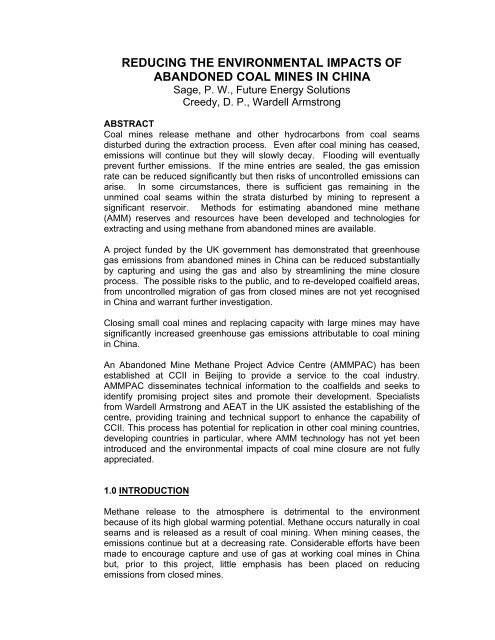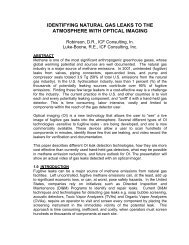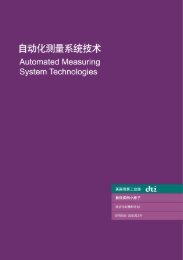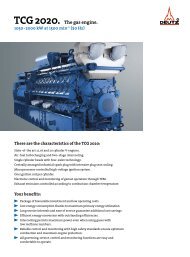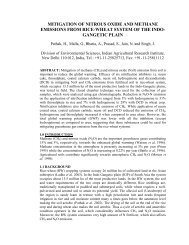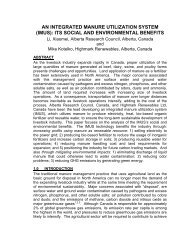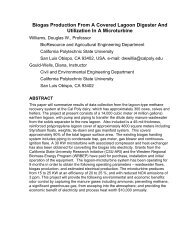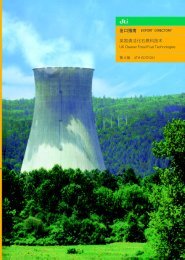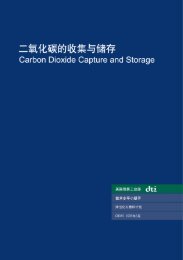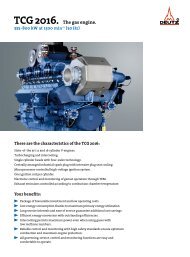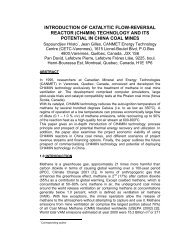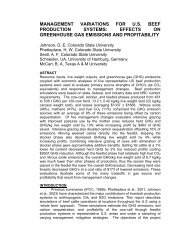reducing the environmental impacts of abandoned coal mines in china
reducing the environmental impacts of abandoned coal mines in china
reducing the environmental impacts of abandoned coal mines in china
Create successful ePaper yourself
Turn your PDF publications into a flip-book with our unique Google optimized e-Paper software.
REDUCING THE ENVIRONMENTAL IMPACTS OF<br />
ABANDONED COAL MINES IN CHINA<br />
Sage, P. W., Future Energy Solutions<br />
Creedy, D. P., Wardell Armstrong<br />
ABSTRACT<br />
Coal <strong>m<strong>in</strong>es</strong> release methane and o<strong>the</strong>r hydrocarbons from <strong>coal</strong> seams<br />
disturbed dur<strong>in</strong>g <strong>the</strong> extraction process. Even after <strong>coal</strong> m<strong>in</strong><strong>in</strong>g has ceased,<br />
emissions will cont<strong>in</strong>ue but <strong>the</strong>y will slowly decay. Flood<strong>in</strong>g will eventually<br />
prevent fur<strong>the</strong>r emissions. If <strong>the</strong> m<strong>in</strong>e entries are sealed, <strong>the</strong> gas emission<br />
rate can be reduced significantly but <strong>the</strong>n risks <strong>of</strong> uncontrolled emissions can<br />
arise. In some circumstances, <strong>the</strong>re is sufficient gas rema<strong>in</strong><strong>in</strong>g <strong>in</strong> <strong>the</strong><br />
unm<strong>in</strong>ed <strong>coal</strong> seams with<strong>in</strong> <strong>the</strong> strata disturbed by m<strong>in</strong><strong>in</strong>g to represent a<br />
significant reservoir. Methods for estimat<strong>in</strong>g <strong>abandoned</strong> m<strong>in</strong>e methane<br />
(AMM) reserves and resources have been developed and technologies for<br />
extract<strong>in</strong>g and us<strong>in</strong>g methane from <strong>abandoned</strong> <strong>m<strong>in</strong>es</strong> are available.<br />
A project funded by <strong>the</strong> UK government has demonstrated that greenhouse<br />
gas emissions from <strong>abandoned</strong> <strong>m<strong>in</strong>es</strong> <strong>in</strong> Ch<strong>in</strong>a can be reduced substantially<br />
by captur<strong>in</strong>g and us<strong>in</strong>g <strong>the</strong> gas and also by streaml<strong>in</strong><strong>in</strong>g <strong>the</strong> m<strong>in</strong>e closure<br />
process. The possible risks to <strong>the</strong> public, and to re-developed <strong>coal</strong>field areas,<br />
from uncontrolled migration <strong>of</strong> gas from closed <strong>m<strong>in</strong>es</strong> are not yet recognised<br />
<strong>in</strong> Ch<strong>in</strong>a and warrant fur<strong>the</strong>r <strong>in</strong>vestigation.<br />
Clos<strong>in</strong>g small <strong>coal</strong> <strong>m<strong>in</strong>es</strong> and replac<strong>in</strong>g capacity with large <strong>m<strong>in</strong>es</strong> may have<br />
significantly <strong>in</strong>creased greenhouse gas emissions attributable to <strong>coal</strong> m<strong>in</strong><strong>in</strong>g<br />
<strong>in</strong> Ch<strong>in</strong>a.<br />
An Abandoned M<strong>in</strong>e Methane Project Advice Centre (AMMPAC) has been<br />
established at CCII <strong>in</strong> Beij<strong>in</strong>g to provide a service to <strong>the</strong> <strong>coal</strong> <strong>in</strong>dustry.<br />
AMMPAC dissem<strong>in</strong>ates technical <strong>in</strong>formation to <strong>the</strong> <strong>coal</strong>fields and seeks to<br />
identify promis<strong>in</strong>g project sites and promote <strong>the</strong>ir development. Specialists<br />
from Wardell Armstrong and AEAT <strong>in</strong> <strong>the</strong> UK assisted <strong>the</strong> establish<strong>in</strong>g <strong>of</strong> <strong>the</strong><br />
centre, provid<strong>in</strong>g tra<strong>in</strong><strong>in</strong>g and technical support to enhance <strong>the</strong> capability <strong>of</strong><br />
CCII. This process has potential for replication <strong>in</strong> o<strong>the</strong>r <strong>coal</strong> m<strong>in</strong><strong>in</strong>g countries,<br />
develop<strong>in</strong>g countries <strong>in</strong> particular, where AMM technology has not yet been<br />
<strong>in</strong>troduced and <strong>the</strong> <strong>environmental</strong> <strong>impacts</strong> <strong>of</strong> <strong>coal</strong> m<strong>in</strong>e closure are not fully<br />
appreciated.<br />
1.0 INTRODUCTION<br />
Methane release to <strong>the</strong> atmosphere is detrimental to <strong>the</strong> environment<br />
because <strong>of</strong> its high global warm<strong>in</strong>g potential. Methane occurs naturally <strong>in</strong> <strong>coal</strong><br />
seams and is released as a result <strong>of</strong> <strong>coal</strong> m<strong>in</strong><strong>in</strong>g. When m<strong>in</strong><strong>in</strong>g ceases, <strong>the</strong><br />
emissions cont<strong>in</strong>ue but at a decreas<strong>in</strong>g rate. Considerable efforts have been<br />
made to encourage capture and use <strong>of</strong> gas at work<strong>in</strong>g <strong>coal</strong> <strong>m<strong>in</strong>es</strong> <strong>in</strong> Ch<strong>in</strong>a<br />
but, prior to this project, little emphasis has been placed on <strong>reduc<strong>in</strong>g</strong><br />
emissions from closed <strong>m<strong>in</strong>es</strong>.
Abandoned m<strong>in</strong>e methane (AMM) is <strong>the</strong> gas rema<strong>in</strong><strong>in</strong>g <strong>in</strong> <strong>abandoned</strong> <strong>coal</strong><br />
<strong>m<strong>in</strong>es</strong> <strong>in</strong> <strong>coal</strong> seams that have been disturbed by longwall m<strong>in</strong><strong>in</strong>g. The<br />
quantity <strong>of</strong> AMM released depends on various factors <strong>in</strong>clud<strong>in</strong>g <strong>the</strong> volume <strong>of</strong><br />
un-worked <strong>coal</strong> <strong>in</strong> <strong>the</strong> strata disturbed by m<strong>in</strong><strong>in</strong>g, <strong>the</strong> residual gas content <strong>of</strong><br />
<strong>the</strong> <strong>coal</strong> still <strong>in</strong> place and <strong>the</strong> rate <strong>of</strong> flood<strong>in</strong>g <strong>of</strong> <strong>the</strong> work<strong>in</strong>gs. Gas leakages to<br />
<strong>the</strong> surface from old <strong>m<strong>in</strong>es</strong> can also create serious hazards to <strong>the</strong> public.<br />
1.1 ABANDONED MINE METHANE PROJECT ADVICE CENTRE<br />
An <strong>abandoned</strong> m<strong>in</strong>e methane project advice centre (AMMPAC) has been<br />
established at <strong>the</strong> Ch<strong>in</strong>a Coal Information Institute (CCII) <strong>in</strong> Beij<strong>in</strong>g. The<br />
primary aim <strong>of</strong> AMMPAC is to identify and promote means for <strong>reduc<strong>in</strong>g</strong><br />
greenhouse gas emissions from <strong>abandoned</strong> <strong>coal</strong> <strong>m<strong>in</strong>es</strong> <strong>in</strong> Ch<strong>in</strong>a with<br />
particular emphasis on <strong>in</strong>troduc<strong>in</strong>g technologies for captur<strong>in</strong>g and exploit<strong>in</strong>g<br />
methane. This one-year project was supported f<strong>in</strong>ancially by <strong>the</strong> UK Foreign<br />
and Commonwealth Office (FCO) through its Climate Change Challenge<br />
Fund.<br />
Primary project tasks were to build <strong>the</strong> capacity <strong>of</strong> CCII to provide an<br />
<strong>in</strong>formation service to m<strong>in</strong><strong>in</strong>g enterprises and project developers through <strong>in</strong>house<br />
tra<strong>in</strong><strong>in</strong>g courses, site visits and personal coach<strong>in</strong>g. Additional tasks<br />
were to identify organisations able to provide design, test<strong>in</strong>g and eng<strong>in</strong>eer<strong>in</strong>g<br />
support services for AMM projects, to provide l<strong>in</strong>ks to potential <strong>in</strong>vestors and<br />
technical specialists and to seek support for <strong>the</strong> cont<strong>in</strong>uation <strong>of</strong> AMMPAC.<br />
AMMPAC has dissem<strong>in</strong>ated research results and technical <strong>in</strong>formation<br />
through various media <strong>in</strong>clud<strong>in</strong>g <strong>the</strong> <strong>in</strong>ternet, exhibitions, conferences,<br />
workshops, papers, guidance documents and tra<strong>in</strong><strong>in</strong>g courses. Information<br />
sheets and technical guidance notes were prepared by <strong>the</strong> UK specialists for<br />
translation <strong>in</strong>to Ch<strong>in</strong>ese and post<strong>in</strong>g on CCII’s web site, <strong>in</strong> addition to be<strong>in</strong>g<br />
made available on request from AMMPAC. Topics covered <strong>in</strong>clude<br />
<strong>environmental</strong>, eng<strong>in</strong>eer<strong>in</strong>g, f<strong>in</strong>ancial and promotional issues.<br />
Tra<strong>in</strong><strong>in</strong>g courses and sem<strong>in</strong>ars have formed a major and successful <strong>in</strong>put to<br />
<strong>the</strong> FCO funded AMMPAC project. These courses have covered technical,<br />
managerial and commercial topics and have formed part <strong>of</strong> <strong>the</strong> overall<br />
AMMPAC development and dissem<strong>in</strong>ation activities. A wide cross section <strong>of</strong><br />
delegates participated <strong>in</strong> <strong>the</strong> tra<strong>in</strong><strong>in</strong>g from government, eng<strong>in</strong>eer<strong>in</strong>g, safety<br />
and academic organisations <strong>in</strong> addition to CCII staff.<br />
Fund<strong>in</strong>g for AMMPAC is be<strong>in</strong>g sought to support its cont<strong>in</strong>uation for a fur<strong>the</strong>r<br />
two years after which it should become self-sufficient as AMM projects are<br />
established.<br />
1.2 BENEFITS OF AMM EXTRACTION AND USE<br />
Capture and utilisation <strong>of</strong> methane from <strong>abandoned</strong> <strong>coal</strong> <strong>m<strong>in</strong>es</strong> provides<br />
several benefits <strong>in</strong>clud<strong>in</strong>g clean energy from a waste material, <strong>reduc<strong>in</strong>g</strong> <strong>the</strong><br />
release <strong>of</strong> a potent greenhouse gas and potential f<strong>in</strong>ancial ga<strong>in</strong> under<br />
emissions trad<strong>in</strong>g and <strong>the</strong> Kyoto Clean Development Mechanism (CDM). Of<br />
importance to local governments <strong>in</strong> Ch<strong>in</strong>a is that AMM schemes could provide
some employment follow<strong>in</strong>g m<strong>in</strong>e closure and assist <strong>the</strong> regeneration <strong>of</strong><br />
former m<strong>in</strong>e sites.<br />
If use <strong>of</strong> <strong>abandoned</strong> m<strong>in</strong>e methane displaced <strong>the</strong> use <strong>of</strong> <strong>coal</strong> locally <strong>the</strong>n this<br />
would have a beneficial effect on both air and water quality and thus positive<br />
human health benefits.<br />
Commercial AMM extraction and utilisation schemes with an <strong>in</strong>stalled capacity<br />
<strong>of</strong> some 60MW e equivalent are operat<strong>in</strong>g <strong>in</strong> <strong>the</strong> UK. Schemes are also<br />
operat<strong>in</strong>g <strong>in</strong> Germany, France, Czech Republic and <strong>the</strong> USA. Most <strong>of</strong> <strong>the</strong><br />
schemes ei<strong>the</strong>r generate electricity or provide fuel gas to <strong>in</strong>dustrial customers.<br />
There is potential for apply<strong>in</strong>g similar technologies <strong>in</strong> Ch<strong>in</strong>a.<br />
1.3 ABANDONED MINE GAS SOURCES<br />
Methane is formed dur<strong>in</strong>g <strong>the</strong> natural <strong>coal</strong>ification process and <strong>the</strong> <strong>coal</strong> m<strong>in</strong><strong>in</strong>g<br />
operation releases some <strong>of</strong> this methane from <strong>the</strong> <strong>coal</strong> be<strong>in</strong>g worked and from<br />
surround<strong>in</strong>g de-stressed <strong>coal</strong> measures. The gas rema<strong>in</strong><strong>in</strong>g <strong>in</strong> <strong>the</strong> disturbed<br />
<strong>coal</strong> seams after m<strong>in</strong><strong>in</strong>g has ceased comprises <strong>the</strong> AMM reservoir. Robust<br />
computer models have been developed and s<strong>of</strong>tware is available for<br />
estimat<strong>in</strong>g this AMM resource. British Coal Corporation research suggests<br />
that <strong>coal</strong> seams up to 150m to 200m above <strong>the</strong> worked seam and 40m to 70m<br />
below may emit gas <strong>in</strong>to work<strong>in</strong>g longwalls. All <strong>of</strong> Ch<strong>in</strong>a’s State-owned <strong>m<strong>in</strong>es</strong><br />
(SOCMs) use longwall or o<strong>the</strong>r cav<strong>in</strong>g methods <strong>of</strong> m<strong>in</strong><strong>in</strong>g that will release gas<br />
from <strong>coal</strong> seams <strong>in</strong> adjacent strata. Most <strong>of</strong> <strong>the</strong> small <strong>coal</strong> <strong>m<strong>in</strong>es</strong> <strong>in</strong> Ch<strong>in</strong>a use<br />
room-and-pillar methods <strong>of</strong> work<strong>in</strong>g. Here most <strong>of</strong> <strong>the</strong> gas emitted comes<br />
from <strong>the</strong> worked seam as little disturbance is transmitted <strong>in</strong>to <strong>the</strong> surround<strong>in</strong>g<br />
strata and thus <strong>the</strong>re is little methane emission follow<strong>in</strong>g closure.<br />
1.4 PRODUCTION OF AMM<br />
The AMM production process relies on gas desorb<strong>in</strong>g from primary <strong>coal</strong> seam<br />
sources enter<strong>in</strong>g goaf areas (worked-out longwall panels) and migrat<strong>in</strong>g along<br />
underground roadways to <strong>the</strong> surface extraction po<strong>in</strong>t. This is achieved by<br />
us<strong>in</strong>g surface extraction pumps to apply a suction pressure to <strong>the</strong> m<strong>in</strong>e. The<br />
quantity <strong>of</strong> gas recoverable will depend on <strong>the</strong> magnitude <strong>of</strong> <strong>the</strong> source and<br />
how much suction pressure can be applied. M<strong>in</strong>e-water may accumulate <strong>in</strong><br />
goaf areas and displace methane <strong>in</strong>to roadways and shallower seam<br />
work<strong>in</strong>gs. Once a goaf area has been flooded, <strong>the</strong> associated primary gas<br />
sources can no longer release gas <strong>in</strong>to <strong>the</strong> work<strong>in</strong>gs. The resource is not lost<br />
but de-water<strong>in</strong>g will be required before <strong>the</strong> desorption processes can be reestablished.<br />
1.5 ENVIRONMENTAL ISSUES<br />
Release <strong>of</strong> methane to <strong>the</strong> atmosphere <strong>in</strong>curs a significant <strong>environmental</strong><br />
penalty because <strong>of</strong> its high GWP. The extent <strong>of</strong> methane release from <strong>coal</strong><br />
<strong>m<strong>in</strong>es</strong> after closure will depend on several factors. These <strong>in</strong>clude <strong>the</strong> volume<br />
and gas content <strong>of</strong> un-m<strong>in</strong>ed <strong>coal</strong> that has been disturbed by m<strong>in</strong><strong>in</strong>g, whe<strong>the</strong>r<br />
or not <strong>the</strong> m<strong>in</strong>e has been sealed and whe<strong>the</strong>r or not <strong>the</strong> work<strong>in</strong>gs have<br />
become flooded.
Gas leakages from old <strong>m<strong>in</strong>es</strong> can also create serious hazards to <strong>the</strong> public. In<br />
<strong>the</strong> UK, for reasons <strong>of</strong> public safety, passive vents are <strong>of</strong>ten <strong>in</strong>stalled <strong>in</strong><br />
<strong>abandoned</strong> shafts, drifts or surface boreholes drilled <strong>in</strong>to <strong>the</strong> work<strong>in</strong>gs to<br />
provide a low resistance leakage path to <strong>the</strong> surface. Thus, as <strong>the</strong> work<strong>in</strong>gs fill<br />
with water, displaced gases will vent freely to <strong>the</strong> atmosphere. In most cases<br />
<strong>the</strong> gas passively vented represents a small proportion <strong>of</strong> <strong>the</strong> resource<br />
rema<strong>in</strong><strong>in</strong>g <strong>in</strong> a m<strong>in</strong>e. The <strong>environmental</strong> emission is considered to be<br />
acceptable <strong>in</strong> <strong>the</strong> light <strong>of</strong> <strong>the</strong> surface emission risk. Situations have been<br />
observed <strong>in</strong> Ch<strong>in</strong>a where surface emission hazards may be occurr<strong>in</strong>g but<br />
<strong>the</strong>re is no awareness <strong>of</strong> <strong>the</strong> potential problems and no data are available.<br />
2.0 COAL MINE CLOSURES IN CHINA<br />
The <strong>coal</strong> m<strong>in</strong><strong>in</strong>g sector <strong>in</strong> Ch<strong>in</strong>a has undergone substantial re-structur<strong>in</strong>g <strong>in</strong><br />
recent years and this process is ongo<strong>in</strong>g. M<strong>in</strong>e closure is an <strong>in</strong>evitable<br />
consequence <strong>of</strong> chang<strong>in</strong>g from a command and control system to a market<br />
system. M<strong>in</strong>es also have a f<strong>in</strong>ite life due to depletion <strong>of</strong> <strong>coal</strong> reserves.<br />
The government <strong>of</strong> Ch<strong>in</strong>a has implemented m<strong>in</strong>e closure policies to address<br />
two separate issues:<br />
• Clos<strong>in</strong>g and bankrupt<strong>in</strong>g <strong>of</strong> more than 120 SOCMs with depleted<br />
resources and no commercial future<br />
• Clos<strong>in</strong>g <strong>of</strong> Town and Village <strong>coal</strong> <strong>m<strong>in</strong>es</strong> (TVCMs) that fail to meet<br />
safety, licens<strong>in</strong>g and resource access criteria to prevent over<br />
production and price <strong>in</strong>stability. In recent years more than 30,000<br />
TVCMs have been closed.<br />
Gassy SOCMs are potential targets for AMM schemes. Extraction and use <strong>of</strong><br />
AMM from say 50 <strong>m<strong>in</strong>es</strong>, at an average production rate <strong>of</strong> 200l/s pure<br />
(equivalent to approximately 7MW <strong>the</strong>rmal), would produce a mitigation<br />
benefit <strong>of</strong> about 4.4Mt <strong>of</strong> CO 2 equivalent per year.<br />
2.1 IMPLICATIONS OF CHINA’S MINE CLOSURE STRATEGY FOR<br />
GREENHOUSE GAS EMISSIONS<br />
As longwall <strong>m<strong>in</strong>es</strong> tend to emit more methane after closure compared with<br />
room-and-pillar <strong>m<strong>in</strong>es</strong>, Ch<strong>in</strong>a government policy to move to larger longwall<br />
m<strong>in</strong><strong>in</strong>g operations is <strong>the</strong>refore likely to result <strong>in</strong> an <strong>in</strong>crease <strong>in</strong> methane<br />
emissions. Improved gas dra<strong>in</strong>age and utilisation <strong>in</strong> <strong>the</strong> large <strong>m<strong>in</strong>es</strong> dur<strong>in</strong>g<br />
work<strong>in</strong>g could mitigate <strong>the</strong> effect to some extent. Extraction <strong>of</strong> AMM after m<strong>in</strong>e<br />
closure could mitigate emissions fur<strong>the</strong>r.<br />
The total methane emissions from both SOCMs and TVCMs can be estimated<br />
to assess <strong>the</strong> possible impact <strong>of</strong> <strong>the</strong> above changes. First order estimates<br />
shown <strong>in</strong> Table 1, neglect any gas emission reduction due to <strong>in</strong>creased gas<br />
utilisation from 1997 to 2001 and assume an average specific emission <strong>of</strong><br />
1m 3 /t for TVCMs and 10m 3 /t for SOCMs. The table is based on <strong>of</strong>ficial <strong>coal</strong><br />
production statistics, and <strong>the</strong>re is some evidence to suggest that TVCM<br />
production may have been understated. An estimated annual <strong>in</strong>crease <strong>in</strong>
methane emissions <strong>of</strong> 1.6 billion m 3 (22Mt CO 2 equivalent) has occurred from<br />
1997 to 2001 while total <strong>coal</strong> production has fallen.<br />
Table 1. Estimated methane emissions from work<strong>in</strong>g <strong>coal</strong> <strong>m<strong>in</strong>es</strong> <strong>in</strong><br />
Ch<strong>in</strong>a<br />
Year Total <strong>coal</strong> SOCMs <strong>coal</strong> TVCMs <strong>coal</strong> billion m 3<br />
production Mt production Mt production Mt methane<br />
1997 1325 705 620 7.7<br />
2001 1106 906 200 9.3<br />
Recent legislation requires all gassy <strong>m<strong>in</strong>es</strong> to practise methane dra<strong>in</strong>age.<br />
Provided uses can be found for <strong>the</strong> gas <strong>the</strong>re is scope for <strong>reduc<strong>in</strong>g</strong> emissions<br />
substantially.<br />
3.0 REDUCING EMISSIONS FROM ABANDONED MINES<br />
Research, discussions and visits to <strong>abandoned</strong> m<strong>in</strong>e sites at Fushun<br />
(Liaon<strong>in</strong>g Prov<strong>in</strong>ce), Tongchuan near Xi’an (Shaanxi Prov<strong>in</strong>ce), X<strong>in</strong>yi at<br />
Hegang (Heilongjiang Prov<strong>in</strong>ce) and Mul<strong>in</strong> near Jixi (Heilongjiang Prov<strong>in</strong>ce)<br />
provided an <strong>in</strong>sight <strong>in</strong>to m<strong>in</strong>e closure procedures and methods reveal<strong>in</strong>g<br />
some aspects <strong>of</strong> <strong>environmental</strong> note. These visits were made dur<strong>in</strong>g a UK<br />
Department for Trade and Industry sponsored technology transfer project to<br />
stimulate <strong>in</strong>terest <strong>in</strong> <strong>the</strong> energy generation potential <strong>of</strong> AMM schemes. Under<br />
<strong>the</strong> auspices <strong>of</strong> AMMPAC a visit was made to Yangquan m<strong>in</strong><strong>in</strong>g group,<br />
Shanxi, to view an embryonic AMM project.<br />
De-water<strong>in</strong>g <strong>of</strong> <strong>coal</strong> m<strong>in</strong>e work<strong>in</strong>gs is sometimes cont<strong>in</strong>ued after closure.<br />
Reasons for this may <strong>in</strong>clude protection <strong>of</strong> adjacent underground work<strong>in</strong>gs, to<br />
enable equipment salvage, <strong>the</strong> prospect <strong>of</strong> re establish<strong>in</strong>g operations and <strong>the</strong><br />
protection <strong>of</strong> surface water quality. De-water<strong>in</strong>g ma<strong>in</strong>ta<strong>in</strong>s access to <strong>the</strong><br />
underground reservoirs from which methane emanates and f<strong>in</strong>ds its way to<br />
<strong>the</strong> surface. If AMM extraction and use is not feasible, allow<strong>in</strong>g early,<br />
controlled flood<strong>in</strong>g would rapidly suppress methane emissions.<br />
The low concentration <strong>of</strong> methane <strong>in</strong> <strong>the</strong> ventilation airflow, typically less than<br />
1%, will preclude a commercial recovery and utilisation option us<strong>in</strong>g currently<br />
available technology. The ventilation air will also reduce <strong>the</strong> partial pressure<br />
<strong>of</strong> methane and lead to a greater rate <strong>of</strong> emission than if ventilation was<br />
halted. Dur<strong>in</strong>g <strong>the</strong> closure period significant volumes <strong>of</strong> greenhouse gases<br />
may be vented. At one site an estimated 420 million m 3 per year <strong>of</strong> methane<br />
was emitted from a closed work<strong>in</strong>g which was partially ventilated. The ma<strong>in</strong><br />
<strong>coal</strong> production had ceased three years ago and still no treatment was<br />
planned.<br />
Protracted m<strong>in</strong>e closure leads to <strong>in</strong>creased costs, additional safety risks and<br />
prolonged methane emissions.
4.0 IDENTIFICATION AND DEVELOPMENT OF POTENTIAL AMM SITES<br />
AMMPAC has identified some prospective site areas and <strong>the</strong>se now need<br />
fur<strong>the</strong>r <strong>in</strong>vestigation.<br />
4.1 DATA COLLECTION AND ANALYSIS<br />
A questionnaire was sent out to 100 Coal M<strong>in</strong><strong>in</strong>g Enterprises. Responses<br />
were not expected from all <strong>of</strong> <strong>the</strong>m as some enterprises operate low gas<br />
<strong>m<strong>in</strong>es</strong> and thus have no <strong>in</strong>terest <strong>in</strong> AMM. Information was requested<br />
<strong>in</strong>clud<strong>in</strong>g numbers <strong>of</strong> <strong>m<strong>in</strong>es</strong> closed and identified for closure, seal<strong>in</strong>g and<br />
flood<strong>in</strong>g status, areas disturbed by m<strong>in</strong><strong>in</strong>g, gas content, gas dra<strong>in</strong>age and<br />
ventilation data.<br />
Replies were obta<strong>in</strong>ed from 17 enterprises and <strong>the</strong> <strong>in</strong>formation entered by<br />
CCII <strong>in</strong>to a database. Follow-up enquiries were made to identify potential<br />
project site areas. It is now for <strong>the</strong> respective enterprises, or <strong>in</strong>dependent<br />
developers, to conduct <strong>in</strong>vestigations. The role <strong>of</strong> AMMPAC will be to provide<br />
guidance as required.<br />
4.2 POSSIBLE AMM SITE AREAS<br />
The data were filtered and site areas elim<strong>in</strong>ated if one or more <strong>of</strong> <strong>the</strong> follow<strong>in</strong>g<br />
conditions applied: gas contents were low, <strong>the</strong> closed <strong>m<strong>in</strong>es</strong> were flooded, a<br />
small area <strong>of</strong> m<strong>in</strong><strong>in</strong>g, no <strong>m<strong>in</strong>es</strong> have been closed or are due for closure with<strong>in</strong><br />
three years. Sites <strong>of</strong> possible <strong>in</strong>terest were subsequently identified <strong>in</strong> <strong>the</strong><br />
prov<strong>in</strong>ces <strong>of</strong> Shanxi (Yangquan Group), N<strong>in</strong>gxia (former Taixi Group), Jiangxi,<br />
(Fengcheng, Y<strong>in</strong>ggangl<strong>in</strong>g), Hunan (Zix<strong>in</strong>g, Lianshao) and Liaon<strong>in</strong>g (Benxi,<br />
Fushun, Fux<strong>in</strong>).<br />
Systematic site appraisals and feasibility studies are now required to<br />
determ<strong>in</strong>e <strong>the</strong> potential <strong>of</strong> AMM resources <strong>in</strong> Ch<strong>in</strong>a. The best prospects are<br />
likely to be <strong>the</strong> <strong>m<strong>in</strong>es</strong> that are due to close but are still accessible to allow for<br />
detailed <strong>in</strong>spection <strong>of</strong> plans and underground preparations prior to closure.<br />
Fengcheng and N<strong>in</strong>gxia Groups have a history <strong>of</strong> <strong>coal</strong> m<strong>in</strong>e methane (CMM)<br />
dra<strong>in</strong>age and utilisation. The Fushun closed <strong>m<strong>in</strong>es</strong> are located close to a<br />
CMM pipel<strong>in</strong>e <strong>in</strong> an area with an established m<strong>in</strong>e gas demand. It should be<br />
noted that <strong>the</strong> three major <strong>coal</strong> m<strong>in</strong><strong>in</strong>g enterprises <strong>in</strong> N<strong>in</strong>gxia have been<br />
amalgamated <strong>in</strong>to <strong>the</strong> N<strong>in</strong>gxia M<strong>in</strong><strong>in</strong>g Industry Group.<br />
Yangquan M<strong>in</strong><strong>in</strong>g Group has probably <strong>the</strong> first AMM scheme <strong>in</strong> Ch<strong>in</strong>a. Albeit<br />
small, <strong>the</strong> <strong>abandoned</strong> m<strong>in</strong>e supplies gas to help meet peak demands from a<br />
CMM scheme dur<strong>in</strong>g w<strong>in</strong>ter.<br />
4.3 AMM PROJECT DEVELOPMENT<br />
Currently available <strong>in</strong>formation <strong>in</strong>dicates <strong>the</strong>re are some potential AMM<br />
project sites but most are likely to be commercially marg<strong>in</strong>al and probably too<br />
small to attract f<strong>in</strong>anc<strong>in</strong>g unless clustered. However, AMM could <strong>of</strong>fer benefits<br />
when <strong>in</strong>tegrated with <strong>coal</strong> m<strong>in</strong>e methane (CMM) schemes as a source <strong>of</strong> gas<br />
to meet peak demands and a reservoir to store gas dur<strong>in</strong>g low demand.
Many <strong>of</strong> <strong>the</strong> commercial factors which <strong>in</strong>fluence <strong>the</strong> viability <strong>of</strong> CMM utilisation<br />
schemes will similarly affect AMM schemes. The ma<strong>in</strong> difference is that AMM<br />
extraction can be controlled to suit demand whereas gas dra<strong>in</strong>age <strong>in</strong> a<br />
work<strong>in</strong>g m<strong>in</strong>e is operated to protect <strong>the</strong> underground workforce as a first<br />
priority.<br />
CDM may <strong>of</strong>fer a potential f<strong>in</strong>anc<strong>in</strong>g route to assist development <strong>of</strong> AMM and<br />
CMM schemes subject to establish<strong>in</strong>g protocols. Flar<strong>in</strong>g might be an option<br />
for small AMM schemes subject to CDM acceptability as a f<strong>in</strong>anc<strong>in</strong>g<br />
mechanism.<br />
Current methods <strong>of</strong> seal<strong>in</strong>g m<strong>in</strong>e entries <strong>in</strong> Ch<strong>in</strong>a are <strong>in</strong>adequate for<br />
<strong>abandoned</strong> m<strong>in</strong>e methane (AMM) schemes and AMMPAC has prepared a<br />
technical guidance note outl<strong>in</strong><strong>in</strong>g <strong>the</strong> necessary requirements.<br />
5.0 CONCLUSIONS AND RECOMMENDATIONS<br />
An advisory centre has been successfully established <strong>in</strong> Beij<strong>in</strong>g to promote<br />
and support AMM developments with <strong>the</strong> aim <strong>of</strong> <strong>reduc<strong>in</strong>g</strong> greenhouse gas<br />
emissions from closed <strong>m<strong>in</strong>es</strong> <strong>in</strong> Ch<strong>in</strong>a. It has enabled experience <strong>of</strong> project<br />
development, technology and management from <strong>the</strong> UK to be transferred to<br />
Ch<strong>in</strong>a.<br />
The most effective approaches to <strong>reduc<strong>in</strong>g</strong> methane emissions after m<strong>in</strong>e<br />
closure are:<br />
• Extraction and utilisation <strong>of</strong> methane from <strong>the</strong> m<strong>in</strong>e after seal<strong>in</strong>g<br />
• Allow<strong>in</strong>g <strong>the</strong> m<strong>in</strong>e work<strong>in</strong>gs to flood as soon as possible after cessation<br />
<strong>of</strong> <strong>coal</strong> production (provided <strong>the</strong>re are no significant <strong>in</strong>rush hazards to<br />
neighbour<strong>in</strong>g <strong>m<strong>in</strong>es</strong> or major groundwater pollution risks), thus<br />
prevent<strong>in</strong>g gas release and migration<br />
The best AMM project prospects are likely to be large SOCMs that will close<br />
soon but are still accessible. Thus, <strong>the</strong> necessary underground eng<strong>in</strong>eer<strong>in</strong>g<br />
works can be undertaken to ensure an effective gas extraction scheme can be<br />
developed. Of <strong>the</strong> <strong>m<strong>in</strong>es</strong> currently identified for closure, not all will be gassy or<br />
necessarily suitable for AMM extraction. In order to achieve commercial scale,<br />
AMM projects may need to be l<strong>in</strong>ked with <strong>coal</strong> m<strong>in</strong>e methane schemes at<br />
work<strong>in</strong>g <strong>m<strong>in</strong>es</strong>.<br />
An unexpected result <strong>of</strong> <strong>the</strong> research is <strong>the</strong> f<strong>in</strong>d<strong>in</strong>g that re-structur<strong>in</strong>g <strong>of</strong> <strong>the</strong><br />
<strong>coal</strong> m<strong>in</strong><strong>in</strong>g sector <strong>in</strong> Ch<strong>in</strong>a by replac<strong>in</strong>g small m<strong>in</strong>e capacity with large <strong>m<strong>in</strong>es</strong><br />
could have <strong>in</strong>creased annual <strong>coal</strong> m<strong>in</strong>e sector emissions by as much as 22Mt<br />
CO 2 equivalent. More gas extraction and utilisation schemes at work<strong>in</strong>g <strong>m<strong>in</strong>es</strong><br />
are urgently needed to reduce this emission. As <strong>coal</strong> production is<br />
concentrated <strong>in</strong> larger <strong>m<strong>in</strong>es</strong>, AMM will become <strong>in</strong>creas<strong>in</strong>gly important <strong>in</strong> <strong>the</strong><br />
future.<br />
The time elapsed between cessation <strong>of</strong> <strong>coal</strong> production and m<strong>in</strong>e<br />
abandonment <strong>in</strong> Ch<strong>in</strong>a is protracted. Coal m<strong>in</strong>e closure procedures should be
accelerated to ensure gas emissions are reduced as soon as possible by<br />
ei<strong>the</strong>r <strong>in</strong>troduc<strong>in</strong>g AMM utilisation schemes where feasible, or allow<strong>in</strong>g<br />
flood<strong>in</strong>g, provided <strong>the</strong>re are no significant <strong>in</strong>rush hazards to neighbour<strong>in</strong>g<br />
<strong>m<strong>in</strong>es</strong> or major groundwater pollution risks.<br />
Any underground salvage operation which delays <strong>the</strong> <strong>in</strong>troduction <strong>of</strong> an AMM<br />
scheme or f<strong>in</strong>al closure should be f<strong>in</strong>ancially justifiable. An environment<br />
appraisal should be undertaken to assess surface stability, gas emission and<br />
m<strong>in</strong>e water recovery aspects <strong>in</strong>clud<strong>in</strong>g <strong>the</strong> identification <strong>of</strong> any necessary<br />
control measures. The schedule should demonstrate that <strong>the</strong> closure and<br />
seal<strong>in</strong>g will be undertaken systematically and swiftly. Thus, f<strong>in</strong>ancial resources<br />
can be directed towards provid<strong>in</strong>g re-tra<strong>in</strong><strong>in</strong>g, and legitimate job creation<br />
schemes.<br />
Prior to closure <strong>of</strong> a gassy m<strong>in</strong>e, <strong>the</strong> feasibility <strong>of</strong> construct<strong>in</strong>g an AMM<br />
extraction and utilisation scheme should be undertaken. The guidance notes<br />
prepared by AMMPAC highlight <strong>the</strong> key factors to be considered and outl<strong>in</strong>e<br />
<strong>the</strong> necessary eng<strong>in</strong>eer<strong>in</strong>g works.<br />
6.0 ACKNOWLEDGEMENTS<br />
Thanks are due to <strong>the</strong> many organisations and <strong>in</strong>dividuals who have<br />
supported AMMPAC events and contributed to its work, and also to <strong>the</strong> staff<br />
<strong>of</strong> CCII without whom <strong>the</strong> project could not have succeeded. The views<br />
expressed are solely those <strong>of</strong> <strong>the</strong> authors.


